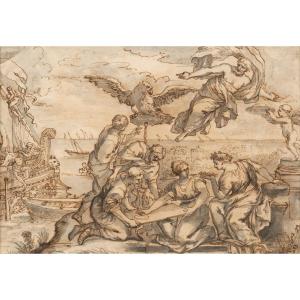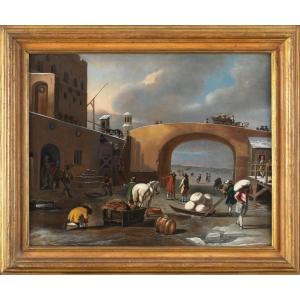In this precious cabinet painting, we are immersed in the center of the nave of a Gothic church which comes to life: while in the foreground a lady appears to confess to a processionary wearing a capirote, characters isolate themselves to meditate and others head towards the choir where a priest dressed in a white chasuble is preparing to give mass. But obviously, architecture is the main subject of the composition and the figures, priests and faithful, are relegated to the rank of simple extras, pretexts to bring the scene to life. Without being really identifiable, our church interior offers features that are similar to several churches in the Netherlands. Alongside an architecture that can be read in a realistic way, purely imaginary and symbolic elements combine in a subtle play of observed details and imagined elements, an extension of the symbolic conception of the image. The first representations of these church interiors appear with the development of Protestantism and the refusal of idolatry. After the iconoclastic attacks, the churches were devoid of any decorative object. However, the need for an image to fix the mind in prayer remained and the interior view of the church took its place from the end of the 16th century, becoming a path of access to the sacred. After the long period of struggle between the Reformed and the Spanish troops, and the birth of the United Provinces, the Catholics in turn appropriated the iconography of church interiors. Under their patronage, places of worship are replenished with altarpieces, crucifixes, paintings representing the life of Christ and statues, as in our painting. We place our composition in the extensive corpus of Steenwijck the Younger in which there are several small format paintings similar to ours. Jacques Foucart, when he evokes the work of Steenwijck, praises "his pearl workmanship, his world of precise clarity to the point of the surreal, the nervous elegance of his architectures, he points out the fine workmanship, which is reinforced by the play of highlighted edges by thin highlights of light, a pure and pearly harmony of gray and blond tones, an impeccable perspective, and the sense of detail which, almost everywhere, furnishes the space and limits the escape of the eye. Among the painters who distinguished themselves in the genre, such as Jan Juriaensz van Baden, Bartholomeus van Bassen or the very famous Neeffs father and son, Hendrick van Steenwijck father and son act as figureheads.
We have chosen to present our precious church interior to you in a spectacular 17th century guillochure ebonized wooden frame.
Dimensions: 20 x 27.5 cm – 47.5 x 54.5 cm with the frame
Biography:
Hendrick II van Steenwyck or Steenwijck known as the Younger (Antwerp 1580 – Leiden 1649) succeeds his father Hendrick I van Steenwyck at the head of the painting studio he runs in Frankfurt. He is one of the pioneers in the representation of architectural interiors. Steenwyck was active in Frankfurt but also in Antwerp between 1604 and 1615 where he collaborated with Frans I Francken, Denis van Alsloot and Jan Brueghel the Elder who painted the figures in his church interiors. Introduced to the English court, he settled in London around 1615. Steenwyck collaborated with the crown painters and painted decorations for Anton van Dyck and Daniel Mytens the Elder. During his stay in Britain, he met his wife Susanna Gaspoel, also an architectural painter. The couple of artists returned to The Hague in 1638 then settled in Leiden around 1642. Steenwyck left behind a significant production and his work undeniably influenced the painting of Peeter Neef I, whom posterity unfairly places at the forefront of painters specializing in this gender.
Bibliography:
- Maillet, Bernard G, Church interiors 1580 – 1720, architectural painting of the Northern schools, Pandora, 2012
- Howarth, Jeremy, The Steenwyck family as masters of perspective, Brepols, 2009
- Foucart, Jacques, Catalog of Flemish paintings and Dutch paintings from the Louvre Museum, Gallimard, 2009

























 Le Magazine de PROANTIC
Le Magazine de PROANTIC TRÉSORS Magazine
TRÉSORS Magazine Rivista Artiquariato
Rivista Artiquariato
